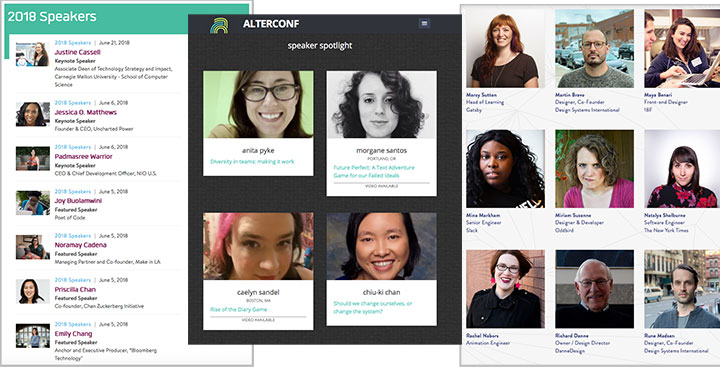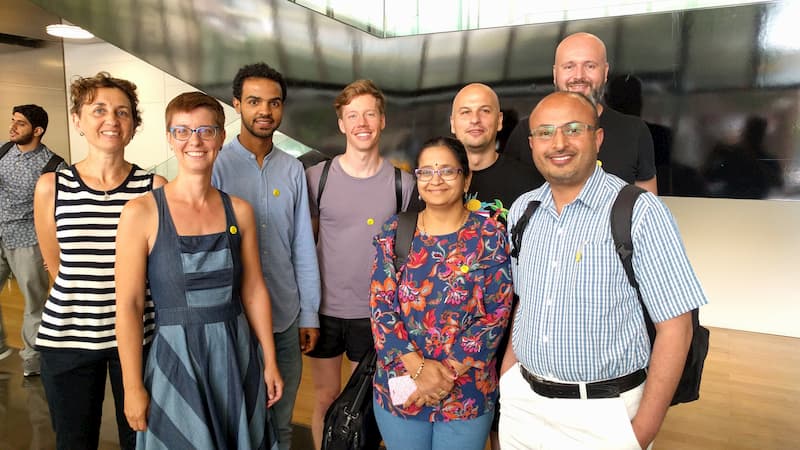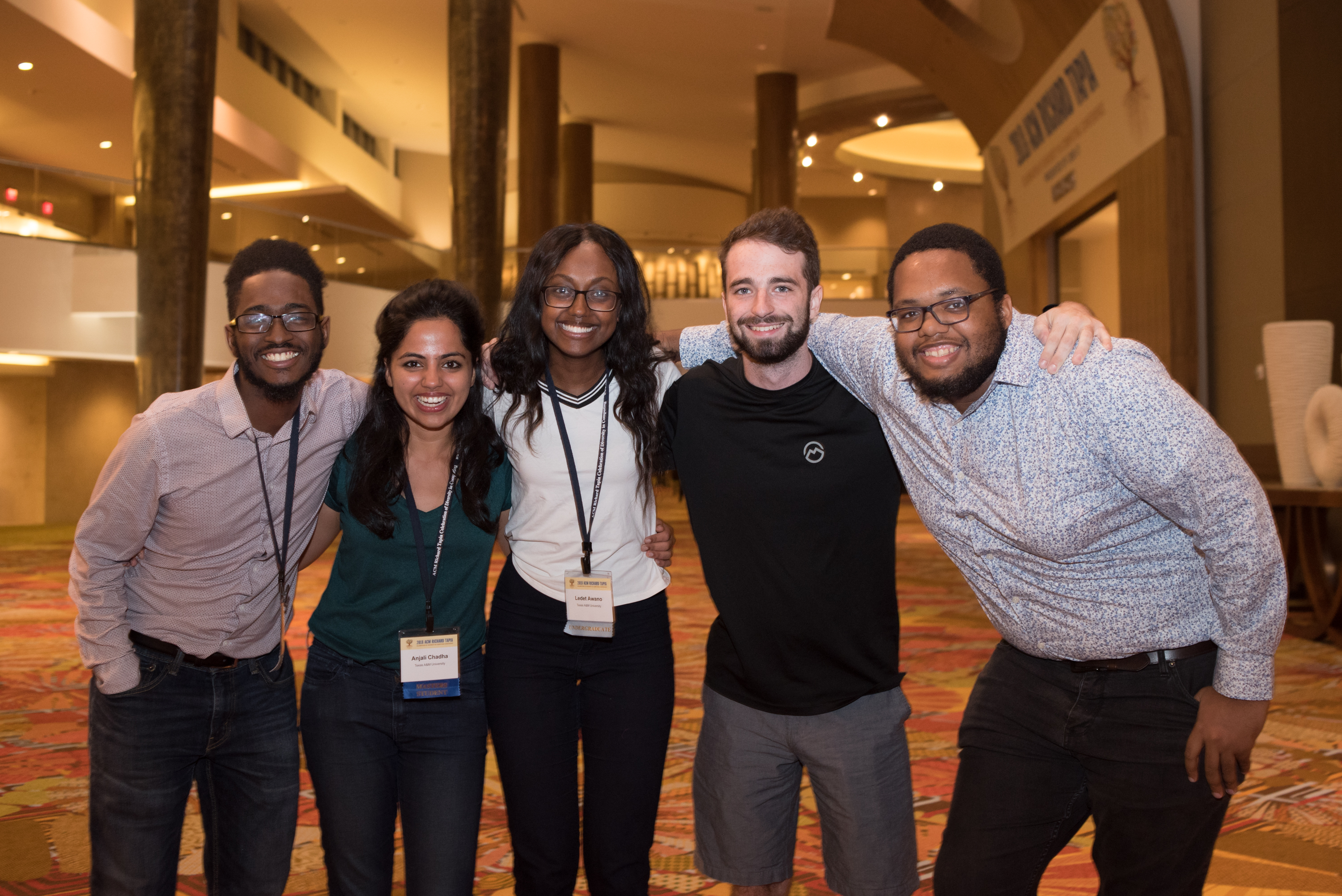Creating a Diversity Scholarship Program for Your Conference
Publikováno: 20.5.2019
My partner and I ran a design and development conference company for eight years. During that time, we produced hundreds of hours of conferences, both on-site and online. Diversity scholarships were only becoming a typical conference offering around the time we decided to sunset our business. So, when we committed to collaborate on an updated ARTIFACT conference, I knew right away I wanted to make Diversity Scholarships available.
We always worked on making our events inclusive, so adding a … Read article
The post Creating a Diversity Scholarship Program for Your Conference appeared first on CSS-Tricks.
My partner and I ran a design and development conference company for eight years. During that time, we produced hundreds of hours of conferences, both on-site and online. Diversity scholarships were only becoming a typical conference offering around the time we decided to sunset our business. So, when we committed to collaborate on an updated ARTIFACT conference, I knew right away I wanted to make Diversity Scholarships available.
We always worked on making our events inclusive, so adding a program that would enhance that inclusion even more seemed like a no-brainer. When I started to research how to create a diversity scholarship program, though, the only examples I could find were finished programs, and not much documentation about the thinking or planning that created them. It’s not unusual to improvise a solution to a problem and make changes on the fly, in fact it's pretty routine when you run a small business. A diversity scholarship program was something I wanted to get right, though — or at least as “right” as possible — the first time around. I decided to look a little deeper than what was available online.
Tech conference organizers: have you offered diversity scholarships for your events? Would you be willing to answer a few questions about it? PM or @ me if interested. TIA!
Other sentient beings reading this: Can I get an RT to reach as many organizers as possible? Thanks!
— Ari Stiles (@ari4nne) March 11, 2019
Twitter helped me find conference organizers who had created and run diversity scholarship programs. I ended up talking to several organizers about their experiences, in addition to comparing a couple dozen programs and applications online.

Before we dive in
There are two types of readers I’d like to address:
- If you don’t think the lack of diversity in tech is a problem, or don’t see why a scholarship program is necessary, this article is not for you. It is written with the assumption that the reader is already convinced of the merits of diversity, and is looking for ways to build a more diverse audience at the conferences or tech events they host; or
- If you are overwhelmed by the lack-of-diversity-in-tech issue, so much that you feel uncomfortable even addressing it, you are not alone. The problem is systemic, with deep, historical roots. It’s important to remember that you alone cannot solve the problems of an entire industry with one program or one event. Focus instead on what you can create, even with limited resources. Ask for help when you need it — most conference organizers I’ve met are glad to help.
From the beginning
So much of the planning for an inclusive conference takes place before you even begin talking about things like diversity scholarships. If your destination city is a relatively inexpensive and easy place to visit; if your venue is accessible and you’ve made plans for accommodations like live captioning; if your ticket prices are reasonable; and if your speaker lineup is genuinely diverse, you’ve got a strong foundation to build on.
Most of this can be accomplished with research. Cities popular with tourists tend to have reasonable transportation and accommodation prices. Cities with big tech hubs often have large, sometimes state-of-the art meeting spaces to hold conferences. Finding cities that have both can be a challenge, but the combination ultimately makes your conference more accessible to different types of attendees.

A little more work may have to go into your speaker lineup. Although there has been some progress on this issue, the majority of tech conferences still mostly feature white men. There have been plenty of articles written on how to create a diverse speaker lineup, but one of my favorite tips is to focus on your conference content first and foremost. Thinking in terms of content makes it easier to look past a potential speaker’s popularity. It also works against your natural bias toward picking “friends” or people you have worked with before. By focusing instead on the content a speaker provides, you can evaluate how that content might add to your overall theme and how it might affect your audience. Curating content is more work than just lining up a group of well-known speakers, but it pays off in the form of a more focused conference and — usually — a more diverse lineup.
You'll also need to encourage open discussion among your co-organizers about diversity issues. My first job in conference planning was for South by SouthWest Interactive (SXSWi), and I feel lucky to have gotten my start working in an environment where these discussions were regular, open, and just “part of the process.” As with any skill, the more you practice talking about diversity, the easier it becomes.
Craft Conference has put together a video about their diversity program. These testimonials may help further the conversation with your colleagues.
Ask yourself why
Diversity and equity scholarship programs have become popular offerings at tech conferences for many reasons. We need more diversity in the industry, and the current thinking is that more diverse conferences can create more leadership and presentation opportunities for underrepresented populations. Diversity can lead to more robust discussions, too. This goal stated plainly on the Web site for #Perfmatters, run by Estelle Weyl:
"We want to ensure the conversation is stimulating and help everyone see their own Web app issues from new and different perspectives. For that, we need attendees with different perspectives. While we love everyone, conferences where all attendees come from corporations with generous continuing education budgets aren’t as interesting for participants as when attendees represent different work and life experiences."
It can be useful to do a little soul-searching to think about why you and your co-organizers want to do this. “More than anything,” says Tenessa Gemelke, organizer of Confab, “we wanted to remove obstacles, not just check boxes.” It’s easy to tell ourselves that because we’ve recruited a few women or people of color, we’ve “taken care of” conference diversity and we can move on to the next task. The needs of your diversity scholarship recipients are not checklist items — they are the building blocks of a more inclusive community.
Brainstorming a bit about the reasons you want to build a diversity scholarship program can help you set goals, identify problems specific to your target audience, and define limits. You might even discover that you have secondary objectives, which is not unusual.
Justin Reese is the Founder of Code & Supply and co-creator of several conferences based in Pittsburgh, PA. In addition to the traditional uses for diversity scholarships, he and his staff occasionally use scholarship funds to send up-and-coming hometown speakers to other cities. “We want people to see the talent and resources we have here in Pittsburgh,” says Reese. He and his team think of Code & Supply scholarships as a way to showcase local talent and build a robust, diverse tech community in their home town.
At ARTIFACT, we think of diversity and inclusion as the future of technology. So, in addition to building a robust, inclusive community, we see our diversity scholarship program as a vital part of a forward-thinking conference. Techniques and workflow change not only because of new gadgets and platforms, but because of new audiences and different types of teams.
Taking stock
Once you’ve settled on your “why,” it’s best to determine your “what” — as in, what you have to offer. Do you have any resources or perks on hand that will require no help from sponsors? For example, some conferences have more space than they need. Can you give some tickets away for free, or at a discount? Or if you have limited space, can you make a few free or discounted tickets possible by bumping up the cost of your other tickets? Make a list of what you can offer for free or from simple changes to your conference plan.
Other services that you might consider offering through your diversity scholarship program:
- Assisting with travel
- Assisting with accommodations
- Meal stipends
- On-site childcare
- On-site nursing / feeding spaces
Some organizers even make travel and hotel reservations for their diversity scholarship attendees. It makes sense — most conferences already make these arrangements for their presenters, so it’s easy to do it for a few more people. This service may help scholarship dollars stretch a little further too, if the extra travel or booked rooms are available at a bulk discount.
If you want to offer more than just the basics, you will probably have to work with sponsors. The good news here is that sponsors often enjoy investing in diversity initiatives. Before approaching a potential sponsor, though, it’s wise to be clear on how you plan to spend the money. Consider creating a one-sheet that states your goals, the underrepresented groups you are trying to recruit, and what perks the sponsor can expect for participating. This way, you have something to leave behind for sponsors who want to think it over or who need to present the idea to others before it gets approval. Be sure to include your contact information.
Set your goals
It’s useful to think about how many diversity scholarships you’d like to offer in an ideal situation. In practice, that perfect number will probably drop based on your budget or lack of space, but having a lofty goal may encourage you to try a little harder.
Among the conference organizers I spoke with, the number of diversity scholarship recipients ranged from two to fifteen percent of total ticket sales. Those with higher numbers started with higher goals.

Making it happen
Figuring out the logistics of a diversity scholarship plan may be the most complicated part of the process. Trying to figure out how to juggle all the tasks involved is what spurred me to do all this research in the first place!
Implementation will include some combination of the following steps, not necessarily in this order:
Put someone in charge
Your entire staff may be involved with processing diversity scholarships, but it’s a good idea to have one person oversee the whole program for the sake of continuity. There is a great deal of communication involved with this process, so it helps to choose a point person with strong organization and communication skills. The most significant qualification, though, is a real passion for creating a diverse conference community.
Create a reasonable timeline
With input from your team, set application deadlines, reviewing deadlines, and scholarship offer deadlines. Every organizer I spoke with suggested making these deadlines early in the process and sticking to them.
You’ll need enough time to review applications and make scholarship offers early enough to give your attendees time to plan. Remember that they might have to request time off work, make family care arrangements, and deal with other obligations. People from out of town need at least two months notice, and international attendees may need three months or more. Early deadlines help everyone. No one in your organization wants to review applications at the last minute anyway, since conference planning gets more intense in the weeks leading up to the event.
Any unclaimed scholarship resources can be used by qualified local attendees in the weeks leading up to your event. Since they don't have to factor in travel or accommodations, it is easier for local attendees to make plans at the last minute.
Make your scholarship program easy to find
Devote a page to your diversity scholarship program on your site, then link to that page as reasonably often as possible. If you can‘t list it in your main menu, consider linking it from the site footer and from the ticket sales page, in addition to posting about it regularly on social media.
Clearly state who qualifies for aid
The list may vary a bit based on your typical audience, but we chose the following criteria:
- People of color
- Indigenous persons
- People with disabilities
- People who identify as LGBTQIA+
- Women
- Veterans and new graduates just beginning their tech careers
- Full-time students
- People who work for nonprofit/educational/government institution with limited funds
- People who are 55 years old or older
- People who are currently unemployed / underemployed
- People experiencing temporary financial hardship
Be sure to list the types of aid available (determined earlier, when you were “taking stock"). It’s also good to let your applicants know that not every application will be accommodated, and that all applications will be verified.
Collect the information you need
Most conferences use some kind of online application form to collect and organize data. If you are not able to code one yourself, Google Forms or Wufoo make it pretty easy to build a form. Keep the application as simple as you can — you’ll need:
- name,
- contact information,
- the reason(s) they qualify for aid (instead of a blank field, consider listing qualifications on the form as a way of reiterating the types of attendees you are trying to recruit),
- the type of aid they are requesting (again, listing they types of aid available will help applicants understand what’s possible), and
- maybe a statement about why they want to attend or why they need aid at this time.
You’ll want the form to compile data in a way that will be easy to sort through later, like a spreadsheet.
Preserve the anonymity of your applicants
Asking for help in a society that values self-sufficiency over shared responsibility can be tough. Don’t make it harder by asking applicants to divulge too much personal information, participate in open interviews with committee members, or meet with sponsors as part of your program. If a committee will be reviewing applications, consider anonymizing the entries before review.
Verify applications
This should be an ongoing process for several reasons. Some applicants will qualify for your program for reasons that are not always verifiable, so the person doing the vetting may need to contact them and clarify the request.
Other applicants may either misunderstand or overlook your qualifying criteria. The most common mistake many applicants make is assuming they qualify for aid only because their employer won’t cover the cost of the conference. This is where additional information will help: why isn’t this covered? Does the company have very limited funds, or is their travel budget just maxed out already? Does the applicant qualify for a diversity scholarship on other grounds? Applicants should know early in the process if their application is refused or if more information is needed.
Evaluate applications
Once the application deadline is met, evaluation begins. If your applications have been properly vetted, then the hardest work is already done. If a committee is evaluating applications, it’s good to not only figure out a way to anonymize applications, but also to streamline the evaluation process. Maybe give each committee member two or three questions to rate for each applicant. Possible evaluation questions:
- How clearly is the need for aid stated?
- How much aid is needed?
- How much would this attendee impact the conference?
- How much would the conference impact this attendee?
These can be rated on a scale, maybe one to ten, with ten being highest. This makes calculating scores easy. Other data you might choose to consider: when was the application received? Do you want to consider more local applicants than those from out-of-town?
Make and process scholarship offers and refusals
Evaluations have been made, so you are probably left with a set of applicants you want to offer scholarships to, some applicants you are not sure about yet, and a few that you plan to refuse. Start by making offers to those applicants you want to help attend the conference. Clearly state how much help you are offering and a deadline for accepting or refusing the offer.
If you are working with a particularly long waiting list, or the process is going slowly (more than two weeks since you began awarding scholarships), it’s courteous to let people know they are on a waiting list.
At ARTIFACT, we are assuming that some applicants may have a change in plans and therefore may have to refuse the scholarship. In that case, we will be passing along their offer to the next person on our waiting list.
Once all the offers have been made and accepted, it’s time to email the rest of the applicants, thank them for their participation, and let them know they won’t be receiving a scholarship offer. If you can, it’s nice to offer something to those who didn’t receive a scholarship: maybe a discounted ticket if they still choose to attend, or an invitation to any after-hour events, where you have room for a few extra people.
Create feedback mechanisms
In addition to all the input you sought from your colleagues in the beginning, you’ll need feedback on every aspect of the program. Make that easy to do by including an email address or link to a feedback form on your scholarship description page, your application form, and anywhere else on your site that seems appropriate. Once you start awarding scholarships, make communication a high priority. Consider creating a way to collect anonymous feedback from scholarship awardees and sponsors—easier to do if you have a larger conference—to foster honest, less inhibited comments.
Wait and see (and listen)
Now that everything needed for your diversity scholarship program is in place, it’s time to follow your plan and take note of what works and what doesn’t. Stay flexible, as you may have to change some parts of your program on the fly. Keep thinking in terms of equity for all of your applicants, and communicate openly about any changes you make. Applicants are more likely to trust a transparent process.
Listen more than you talk. Always.

Follow up
Once ARTIFACT 2019 has concluded, I’ll be compiling all of our results and feedback in one place and writing a follow-up to this article. Until then, I’d like to thank all the conference organizers who took the time to answer my questions about diversity scholarship programs: Tenessa Gemelke, Estelle Weyl, Justin Reese, Val Head, Dave Poole, Jenn Strater, Ádám Boros, and PJ Hagerty.
In the meantime, here are some other resources you might find helpful:
- Follow Ashe Dryden on Twitter. She gives presentations on diversity and inclusion, and is currently working on two books about the subject.
- Take a look at AIGA’s Diversity and Inclusion resources.
- Anita Singh wrote a pretty comprehensive piece on diversity and inclusion in hiring for Code Like a Girl, and plenty of it applies to conference diversity, too.
The post Creating a Diversity Scholarship Program for Your Conference appeared first on CSS-Tricks.